Christmas Cranberry Herb Butter Roast Chicken
Ingredients
- 1 (4-5 pound) whole chicken
- 1 cup fresh cranberries
- 1/2 cup (1 stick) unsalted butter, softened
- 1/4 cup chopped fresh rosemary
- 1/4 cup chopped fresh thyme
- 2 cloves garlic, minced
- 1 lemon, zested and juiced
- 1 orange, zested and juiced
- 1 teaspoon salt
- 1/2 teaspoon black pepper
- 1 onion, quartered
- 2 carrots, chopped
- 2 celery stalks, chopped
- 1 cup chicken broth
- 2 tablespoons olive oil
Step-by-Step
1. Preheat your oven to 425°F (220°C).
2. Rinse the chicken inside and out and pat it dry with paper towels.
3. In a bowl, combine the softened butter, rosemary, thyme, minced garlic, lemon zest, orange zest, salt, and pepper. Mix well until fully combined.
4. Gently loosen the skin of the chicken breast and thighs with your fingers.
5. Stuff about half of the herb butter mixture under the skin, spreading it evenly.
6. Rub the remaining herb butter all over the outside of the chicken.
7. Stuff the cavity of the chicken with the quartered onion, chopped carrots, celery stalks, cranberries, lemon juice, and orange juice.
8. Place the chicken in a roasting pan. Drizzle with olive oil.
9. Pour chicken broth into the bottom of the roasting pan.
10. Roast for 1 hour and 15 minutes, or until a meat thermometer inserted into the thickest part of the thigh registers 165°F (74°C). Baste the chicken with pan juices every 20 minutes.
11. Let the chicken rest for 10-15 minutes before carving.
12. Carve and serve with the pan juices.
Perfecting Your Christmas Roast Chicken
Roasting a chicken can seem intimidating, but with the right techniques, you can achieve a moist, flavorful, and beautifully browned bird every time. This cranberry herb butter version adds a festive twist that’s perfect for the Christmas season.
Selecting the Right Chicken
Choosing a high-quality chicken is the first step to a successful roast. Look for a chicken that is plump and has smooth, unbroken skin. Organic and free-range chickens often have better flavor and texture.
Consider the size of the chicken in relation to the number of people you are serving. A 4-5 pound chicken will generally feed 4-6 people.
Don’t be afraid to ask your butcher for advice. They can help you select the best chicken for your needs and even offer helpful tips for preparation.
Herb Butter Mastery
The herb butter is the star of this recipe, infusing the chicken with incredible flavor and helping to keep it moist. Using fresh, high-quality herbs is essential.
Experiment with different herb combinations. Sage, parsley, and marjoram are also excellent choices. Adjust the amount of garlic to your preference.
Make sure the butter is softened to room temperature before mixing it with the herbs and spices. This will make it easier to spread under the skin and over the outside of the chicken.
Achieving Crispy Skin
Crispy skin is the hallmark of a perfectly roasted chicken. There are several techniques you can use to achieve this.
Pat the chicken dry thoroughly with paper towels before applying the herb butter. Moisture is the enemy of crispy skin.
Roast the chicken at a high temperature (425°F or 220°C) for the first 15-20 minutes, then reduce the heat to 350°F (175°C) for the remainder of the cooking time. This will help to render the fat and crisp the skin.
Basting the chicken with pan juices every 20 minutes will also help to promote browning and crispness.
Consider using a roasting rack to elevate the chicken above the pan juices. This will allow air to circulate around the chicken and promote even browning.
Ensuring Even Cooking
Even cooking is crucial to avoid overcooked breast meat and undercooked thighs. There are several ways to ensure that your chicken cooks evenly.
Truss the chicken with kitchen twine to hold its shape and promote even cooking.
Consider using an oven-safe meat thermometer to monitor the internal temperature of the chicken. Insert the thermometer into the thickest part of the thigh, avoiding the bone.
If the breast starts to brown too quickly, you can tent it with foil to prevent it from burning.
Let the chicken rest for 10-15 minutes before carving. This will allow the juices to redistribute throughout the meat, resulting in a more moist and flavorful bird.
Delicious Pan Gravy
Don’t let those delicious pan juices go to waste! They can be transformed into a flavorful gravy to serve with your roast chicken.
Remove the chicken from the roasting pan and set it aside to rest.
Place the roasting pan over medium heat. Add a tablespoon of flour to the pan drippings and whisk until smooth. Cook for 1-2 minutes to cook out the raw flour taste.
Gradually whisk in 1-2 cups of chicken broth, scraping up any browned bits from the bottom of the pan.
Bring the gravy to a simmer and cook until it has thickened to your desired consistency.
Season the gravy with salt, pepper, and any other herbs or spices you like.
Strain the gravy through a fine-mesh sieve for a smoother texture.
Serving Suggestions for Your Christmas Feast
This Christmas Cranberry Herb Butter Roast Chicken is a show-stopping centerpiece for your holiday meal. Here are some serving suggestions to complement its delicious flavor:
Classic Holiday Sides
Pair your roast chicken with classic holiday sides such as mashed potatoes, stuffing, green bean casserole, and sweet potato casserole.
Roasted Brussels sprouts with bacon and balsamic glaze are another excellent option.
Don’t forget the cranberry sauce! A homemade cranberry sauce with orange zest and cinnamon is the perfect accompaniment to the chicken.
A simple green salad with a light vinaigrette will provide a refreshing contrast to the richness of the meal.
Wine Pairings
A crisp white wine such as Sauvignon Blanc or Pinot Grigio will complement the flavors of the chicken and herbs.
A light-bodied red wine such as Pinot Noir or Beaujolais is also a good choice.
For a festive touch, serve a sparkling wine such as Prosecco or Champagne.
Festive Desserts
Complete your Christmas feast with a selection of festive desserts.
A classic Christmas fruitcake is always a popular choice.
Pecan pie, pumpkin pie, or apple pie are also delicious options.
For a lighter dessert, consider a cranberry and orange tart or a gingerbread parfait.
Presentation is Key
Presentation is an important part of creating a memorable Christmas meal.
Garnish the roast chicken with fresh herbs and cranberries.
Arrange the side dishes artfully around the chicken on a large platter.
Use your best china and silverware to set the table.
Light candles and play festive music to create a warm and inviting atmosphere.
Leftover Transformation
Even after the Christmas feast is over, you can continue to enjoy the delicious flavors of your roast chicken.
Use leftover chicken to make sandwiches, salads, or soups.
Shred the chicken and use it to make tacos or enchiladas.
Add the chicken to a pasta dish or stir-fry.
Use the leftover chicken carcass to make chicken broth.
Tips and Tricks for Roast Chicken Success
Roasting a chicken is a simple process, but there are a few key tips and tricks that can help you achieve perfect results every time.
Thawing the Chicken
If you are using a frozen chicken, it is important to thaw it completely before roasting.
The safest way to thaw a chicken is in the refrigerator. This can take several days, so plan accordingly.
You can also thaw a chicken in a cold water bath, changing the water every 30 minutes. This method is faster but requires more attention.
Never thaw a chicken at room temperature, as this can promote the growth of bacteria.
Dry Brining
Dry brining is a technique that involves salting the chicken several hours or even a day before roasting. This helps to season the chicken throughout and results in a more moist and flavorful bird.
Simply sprinkle the chicken liberally with salt, both inside and out, and place it in the refrigerator uncovered.
The salt will draw moisture out of the chicken, which will then be reabsorbed, carrying the salt deep into the meat.
Basting Frequency
Basting the chicken with pan juices is important for keeping it moist and promoting browning. However, basting too frequently can lower the oven temperature and prolong the cooking time.
Baste the chicken every 20 minutes or so, using a baster or spoon.
Be careful not to over-baste, as this can make the skin soggy.
Checking for Doneness
The most accurate way to check for doneness is to use an oven-safe meat thermometer. Insert the thermometer into the thickest part of the thigh, avoiding the bone.
The chicken is done when the internal temperature reaches 165°F (74°C).
You can also check for doneness by piercing the thigh with a fork. If the juices run clear, the chicken is done.
Resting Time is Key
Allowing the chicken to rest for 10-15 minutes before carving is crucial for ensuring a moist and flavorful bird.
During this time, the juices will redistribute throughout the meat, resulting in a more tender and succulent result.
Cover the chicken loosely with foil while it rests to keep it warm.
Troubleshooting Common Roast Chicken Problems
Even with the best techniques, you may encounter some common problems when roasting a chicken. Here’s how to troubleshoot them:
Chicken is Dry
- Make sure you are not overcooking the chicken. Use a meat thermometer to check for doneness.
- Try dry brining the chicken before roasting.
- Baste the chicken frequently with pan juices.
- Make sure the oven temperature is accurate.
Skin is Not Crispy
- Pat the chicken dry thoroughly with paper towels before roasting.
- Roast the chicken at a high temperature for the first 15-20 minutes.
- Use a roasting rack to elevate the chicken above the pan juices.
- Avoid over-basting the chicken.
Chicken is Unevenly Cooked
- Truss the chicken with kitchen twine.
- Make sure the oven temperature is consistent.
- Rotate the chicken halfway through the cooking time.
- If the breast starts to brown too quickly, tent it with foil.
Gravy is Too Thin
- Cook the flour and pan drippings for a longer period of time to thicken the gravy.
- Add a cornstarch slurry (1 tablespoon cornstarch mixed with 2 tablespoons cold water) to the gravy and simmer until thickened.
Gravy is Too Thick
- Add more chicken broth to the gravy to thin it out.
FAQ About Christmas Roast Chicken
Q: How long does it take to roast a chicken?
A: Roasting time depends on the size of the chicken. A 4-5 pound chicken typically takes 1 hour and 15 minutes to 1 hour and 30 minutes to roast at 425°F (220°C). Always use a meat thermometer to check for doneness.
Q: How do I keep my roast chicken from drying out?
A: To keep your roast chicken moist, pat it dry before roasting, stuff herb butter under the skin, baste frequently with pan juices, and don’t overcook it. Letting it rest before carving is also essential.
Q: What temperature should my roast chicken be?
A: The internal temperature of the chicken should reach 165°F (74°C) in the thickest part of the thigh.
Q: Can I prepare the chicken ahead of time?
A: You can prepare the herb butter and chop the vegetables ahead of time. You can also stuff the chicken with the herb butter and vegetables up to 24 hours in advance. Store the prepared chicken in the refrigerator.
Q: What do I do with the leftover chicken carcass?
A: Use the leftover chicken carcass to make chicken broth. It’s a great way to reduce food waste and create a flavorful base for soups and sauces.




